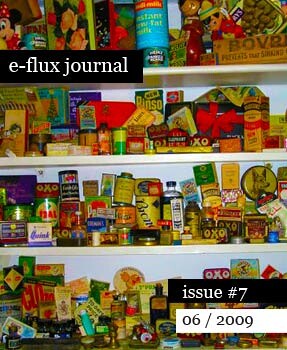e-flux journal – issue #7
Summer 2009
Available online:
http://e-flux.com/journal
The processes of the factory have entered the museum in ways that Warhol and Duchamp could never have dreamed: the amount of art production now by far exceeds what can be processed or understood, and this often creates a degree of mistrust and an absence of common points of reference with which to not only discuss, but also to gain anything from the sheer volume of artworks placed on display today. The time to engage and digest work is often replaced by additional work—it just keeps coming down the line.
Hito Steyerl describes how the workers who left the factory have returned to the same space—now converted into a museum—as visitors. With the displacement of cinema to the space of the museum, Steyerl discovers the shape of a new form of labor in spectatorship at the social factory of the contemporary museum. When so much cinematic duration is placed on display—more than a single person can possibly see—making sense of an exhibition’s totality then defers to the multitude to collectively reconstruct the meaning of the factory as a space of production and a space of work. “If the factory is everywhere, then there is no longer a gate by which to leave it—there is no way to escape relentless productivity.” (see full essay here)
Raqs Media Collective compares this multitude to a million earthworms collectively turning the soil of cultural work, each doing what they do best and in their own time. Though there may be no escape from the trials of performance and production, “Earthworms Dancing: Notes for a Biennial in Slow Motion” suggests that one way of reclaiming a relationship with what is produced could be through a measured patience. When one finds so many large-scale exhibitions in disparate locations making more or less the same claims, a “capaciousness and generosity towards realities that may either be, or may seem to be in hibernation, dormant, or still in formation” may also be the only means of engaging the often radically disparate contexts from which these similar expressions emerge. (see full essay here)
Omnia El Shakry gives an account of how the Cairo Youth Salon became a hotbed of debate on the nature of artistic autonomy and curatorial sovereignty. When the Egyptian Ministry of Culture attempted to counteract its own bureaucratic inertness by inviting onto the jury of the annual exhibition a group of young artists and curators from outside its usual roster, the government institution found itself faced with a number of difficult questions concerning the complexity of its own role as a highly centralized arts institution vis-à-vis an increasingly savvy and dispersed art public. In subjecting its institutional understanding of public responsibility to artists working according to their private will (while still addressing a public), the Ministry inadvertently placed itself at the center of a debate about the complex role of a dynamic institution that must simultaneously serve and challenge a public. (see full essay here)
Pauline Yao looks at how the overwhelmingly top-down paradigm of contemporary art in China can be overturned by means of initiatives that emerge from more modest forms of artistic engagement. If such forms of “engaged autonomy” can find ways of balancing the persistent realities of market interests in Chinese contemporary art with artistic approaches that either employ commerce in productive ways or assert their relevance without validation from the market, more immanent and sustainable systems of production and reception certainly might emerge. (see full essay here)
One form of sustainable production and reception might be the “Art of Conversation.” In her conversational sequel to her contribution from issue #3, Monika Szewczyk suggests that “we may be increasingly interested in considering the aesthetics of people talking together.” Examining the core components of discursive practice, she traces its effects and affects back to class, oral traditions, and liberal education; recalls the power of a simple voice speaking truth to an emperor; and looks at silence as a strategy. (see full essay here)
Boris Groys‘ “Self-Design and Aesthetic Responsibility” elaborates on the unforeseen side effects of modernist design, first discussed by the author in e-flux journal #0 in “The Obligation to Self-Design.” Now that the modernist ethic of truthful and transparent design has been consolidated into an aesthetic mode to be invoked arbitrarily, any form of “honest design” becomes the object of deep suspicion. Artists have spoken to this with various forms of self-denunciation, confirming and re-confirming this suspicion by similarly designing themselves as charlatans and profiteers. Yet however these approaches may address the skepticism of an audience faced with artworks evaluated according to dubious market values, the question of how art can assert its own inner value under these conditions remains an open one. (see full essay here)
In the last installment of Michael Baers‘ “Concerning Matters to be Left for a Later Date,” Annika Eriksson asks our protagonist to pay a visit to Folkets Park in Malmö, a place that poses a number of questions for Baers about the origins and fate of social democracy in Sweden. Struggling with Eriksson to reconcile socialist optimism with the boredom of social consensus, Baers compares Folkets Park to “a socialist wildlife preserve”—a sign of ideological dismay—and returns home to receive a pamphlet in the mail for “Artisternas Park”… (see full essay here)
Finally, Brian Kuan Wood crosses two contributions from issue #6—by Marion von Osten and by Mariana Silva and Pedro Neves Marques—in a reflection on the possibilities for asserting a universal legitimacy for artworks. If somehow the agency claimed by self-builders in response to the failed universalist aspirations of modernist town planning were taken in their individual instances as discrete proposals for entirely new towns, a mode of logic might emerge that is capable of asserting an inherent, however speculative, value for works of art. (see full essay here)


